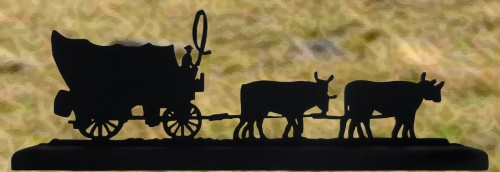
The following story is about Louisa Free Lee Wells, who crossed the Plains with one of the first companies of pioneers.
Louisa Free was a young girl in Nauvoo who became one of the many wives of John Doyle Lee (infamous for his involvement and execution over the Mountain Meadows Massacre). Even though he was faithful and protective of the prophet Joseph, there was much strife in his household and many of his wives left him, including Louisa Free, whom by then had a baby boy.
Louisa returned to her family and prepared to cross the Plains with their two wagons. It took all the money they had, so there was not enough to hire a second driver. At twenty-two years of age, this job fell upon Louisa, who had never led a team of oxen before. It was necessary for her to take on this responsibility and she valiantly took the challenge.
After settling her younger siblings and baby in the wagon, she tied her sunbonnet on, carried a parasol in one hand, and an ox whip in the other. Placing herself by the side of her leading yoke of oxen, she bravely set out.
A yoke typically connects two oxen, although there are yokes for just one ox. These animals are large and they would have probably been taller than Louisa. When trained they can be gentle, but of course, must always be reminded that they are working.
To drive an oxen team, you typically stand on the left side of the team with a whip. Mostly, you use commands such as:
Gee—to turn right
Haw—to turn left
Whoa—to stop
Get Up—to speed up
Easy—to slow down
The whip just reinforces what the command is. For example: if you want the team to turn, you might whip the hind quarter of the one ox and the head of the other ox to tell them who should slow down and who should speed up to make the turn. Then of course, you need a wide berth as to not make the wagon wheels lock against the wagon bed.
Louisa was probably given a quick lesson on what to say, and what to do, and then she was left on her own to manage. A well trained team wouldn’t have given her too much trouble.
At first, things went smoothly along the trail, but as so often happens on the Plains, the rain came in giant gusts. She quickly found her parasol was of no help, so she tossed it aside and trudged onward. Day after day she walked coaxing the oxen team. The oxen cooperated, for the most part, but the weather was not kind. Her sunbonnet, having lost its support, would flop into her face and her clothing became stiff as it dried in the heat, only to weigh her down when the rain fell again.
When they reached the Sweetwater River, she let her oxen drink. Before she realized what was happening, the oxen collapsed; poisoned from the alkali water. She was forced to yoke a couple of her cows. These animals were not trained, so those simple commands were of no use. The whip would have been used much more. The rest of the way would have brought on a lot of screaming and yelling toward the animals. I wonder who was more patient: Louisa or the cows?
 Another wagon, traveling nearby, carried Mrs. McCarthy who was sick. Louisa was asked to sit with her each night to see to her needs. So, after whipping the cows to keep them going during the day, she would drop her whip, leave her team with the family, and keep vigil over the sick woman all night. For three weeks she nursed Mrs. McCarthy, getting little rest, but somehow she maintained good health throughout the journey.
Another wagon, traveling nearby, carried Mrs. McCarthy who was sick. Louisa was asked to sit with her each night to see to her needs. So, after whipping the cows to keep them going during the day, she would drop her whip, leave her team with the family, and keep vigil over the sick woman all night. For three weeks she nursed Mrs. McCarthy, getting little rest, but somehow she maintained good health throughout the journey.
Walking every step of the way, she wore out three pairs of shoes provided for her at the beginning of the crossing. After that she was obliged to wear rags on her feet for protection. These did little, however, because her feet bled through the rags on the trail.
Along the way she became acquainted with General Daniel H. Wells. She later married him shortly after arriving in the Salt Lake Valley. As the senior wife of that great patriarch, she became known as Aunt Louisa. Throughout her life she was celebrated for her generous spirit and acts of charity.